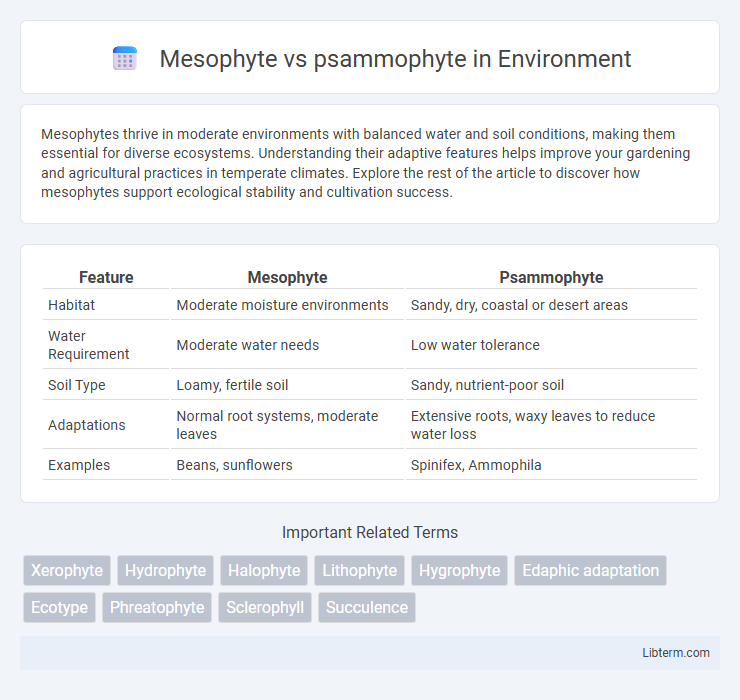Mesophytes thrive in moderate environments with balanced water and soil conditions, making them essential for diverse ecosystems. Understanding their adaptive features helps improve your gardening and agricultural practices in temperate climates. Explore the rest of the article to discover how mesophytes support ecological stability and cultivation success.
Table of Comparison
| Feature | Mesophyte | Psammophyte |
|---|---|---|
| Habitat | Moderate moisture environments | Sandy, dry, coastal or desert areas |
| Water Requirement | Moderate water needs | Low water tolerance |
| Soil Type | Loamy, fertile soil | Sandy, nutrient-poor soil |
| Adaptations | Normal root systems, moderate leaves | Extensive roots, waxy leaves to reduce water loss |
| Examples | Beans, sunflowers | Spinifex, Ammophila |
Introduction to Mesophytes and Psammophytes
Mesophytes are plants adapted to environments with moderate water availability, thriving in well-balanced soil moisture conditions essential for optimal growth. Psammophytes grow in sandy, nutrient-poor soils characterized by low water retention, showcasing specialized adaptations such as deep root systems to survive harsh, arid habitats. Understanding these distinct plant types highlights their ecological roles and survival strategies in contrasting terrestrial ecosystems.
Defining Mesophytes: Key Characteristics
Mesophytes are plants adapted to environments with moderate water availability, neither too dry nor too wet, exhibiting balanced root systems and well-developed vascular tissues for efficient water transport. They typically possess broad leaves with stomata regulated to optimize gas exchange and minimize water loss. Unlike psammophytes, which thrive in sandy, nutrient-poor soils, mesophytes favor fertile, well-drained soils with stable moisture conditions.
Defining Psammophytes: Unique Adaptations
Psammophytes are specialized plants adapted to sandy, nutrient-poor environments, exhibiting traits such as deep rooting systems and tolerance to drought and wind erosion. These adaptations enable them to stabilize shifting sand dunes and conserve water efficiently, contrasting with mesophytes that thrive in moderate moisture conditions with less extreme soil challenges. The unique physiological and morphological features of psammophytes, including thick cuticles and reduced leaf surfaces, optimize survival in arid, unstable substrates.
Ecological Niches: Where Mesophytes and Psammophytes Thrive
Mesophytes thrive in habitats with moderate water availability and well-balanced soil moisture, typically occupying forest floors, grasslands, and agricultural fields where water supply is neither excessive nor scarce. Psammophytes specialize in colonizing sandy, nutrient-poor environments such as coastal dunes, deserts, and sandy riverbanks, where their adaptations allow survival under drought stress and shifting substrates. The ecological niches of mesophytes and psammophytes highlight contrasting soil moisture regimes and substrate types essential for their physiological functions and competitive success.
Soil and Water Requirements: Mesophyte vs Psammophyte
Mesophytes thrive in moderate soil moisture conditions with well-drained, fertile soils that retain sufficient water for growth, requiring consistent but not excessive hydration. Psammophytes are adapted to sandy, nutrient-poor soils with low water retention capacity, exhibiting drought tolerance by accessing deep water reserves or reducing water loss. The contrasting soil texture and moisture availability define their distinct ecological niches, influencing root structure and water absorption mechanisms.
Morphological Differences Between Mesophytes and Psammophytes
Mesophytes exhibit broad, thin leaves with a large surface area optimized for moderate water availability, whereas psammophytes possess small, thick, and often waxy or hairy leaves to minimize water loss in sandy, arid environments. Root systems in mesophytes are typically shallow and fibrous, suited for nutrient-rich soils, while psammophytes develop deep, extensive roots to anchor in loose sand and access deep water sources. The structural adaptations in psammophytes also include specialized epidermal layers and reduced stomatal density to enhance drought resistance compared to the relatively delicate morphology of mesophytes.
Physiological Adaptations to Environmental Stress
Mesophytes exhibit physiological adaptations such as moderate stomatal density and efficient water-use mechanisms to thrive in environments with adequate moisture, allowing for balanced photosynthesis and transpiration rates. Psammophytes possess specialized xerophytic traits like deep root systems, reduced leaf surface area, and enhanced osmotic adjustment to withstand arid, sandy habitats with limited water availability. These adaptations enable psammophytes to maintain cellular hydration and metabolic function despite extreme soil dryness and high evaporative demand.
Examples of Mesophyte and Psammophyte Species
Mesophyte species such as Acer saccharum (sugar maple), Zea mays (corn), and Oryza sativa (rice) thrive in environments with moderate water availability and nutrient-rich soils. Psammophyte species including Ammophila arenaria (European beachgrass), Cakile maritima (sea rocket), and Elymus farctus (sea lyme grass) are adapted to sandy, nutrient-poor, and well-drained soils typical of coastal dunes and desert margins. These examples highlight the ecological specialization of mesophytes and psammophytes to their distinct habitats.
Importance in Ecosystem Function and Biodiversity
Mesophytes play a crucial role in maintaining ecosystem function and biodiversity by supporting diverse plant and animal communities in moderately moist environments, facilitating nutrient cycling, and providing habitat stability. Psammophytes are vital in stabilizing sandy soils and preventing erosion in arid and coastal regions, contributing to ecosystem resilience and offering specialized niches for unique flora and fauna. Both plant types enhance ecological balance by sustaining varied habitats, promoting species diversity, and supporting overall ecosystem productivity.
Summary: Mesophyte vs Psammophyte—Key Differences and Similarities
Mesophytes thrive in environments with moderate water availability, exhibiting adaptations like broad leaves and well-developed vascular systems to optimize water use. Psammophytes are specialized plants adapted to sandy, nutrient-poor soils, often displaying extensive root systems and xerophytic features to retain moisture and stabilize dunes. Both types demonstrate unique survival strategies that reflect their ecological niches, highlighting differences in habitat preference, water management, and structural adaptations.
Mesophyte Infographic

 libterm.com
libterm.com